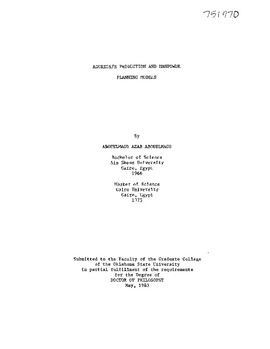| dc.contributor.advisor | Wolfe, Philip M. | |
| dc.contributor.author | Abouelmagd, Abouelmagd Azab | |
| dc.date.accessioned | 2015-09-11T19:30:33Z | |
| dc.date.available | 2015-09-11T19:30:33Z | |
| dc.date.issued | 1985-05 | |
| dc.identifier.uri | https://hdl.handle.net/11244/17585 | |
| dc.description.abstract | Scope of Study: This research incorporates the personnel transition rates, inherent in all industrial situations, into the aggregate planning problem, and introduces the definition of the aggregate production and manpower planning problem. Two models are developed. The first is a linear programming model in which the Orrbeck model is used for the purpose of comparison and as a point of departure from which the new model is developed. The second is an extension of the first model from a single objective to a multiple objectives decision making model, and the goal programming is used as a method of multiple objectives procedures. The analysis of these models indicate their capabilities in presenting more realistic situations than existing models. A nondominance algorithm is developed to test the dominance of the goal programming solution, and to generate a nondominated solution if the goal programming solution turns out to be dominated. Also, a solution methodology for linear goal programming to include all the goals in the optimization process is proposed. | |
| dc.description.abstract | Findings and Conclusions: A substantial improvement in the model's results can be obtained by integrating the personnel transition matrix with manpower requirements. For instance, the results of the first model indicate that the performance of the new model is better than that of the Orrbeck model in representing more realistic situations and providing substantial savings for the two cases that are considered. The solution methodology developed in this research is applied to the second model and all the goals are included in the optimization process. A preferred solution (goal programming solution) and a nondominated solution are also obtained. The new method enables the decision maker to be involved in the optimization process and to provide reasonable aspiration levels for the targets, particularly if the targets are not known. Some of the goal programming difficulties are discussed and solved by the nondominance algorithm developed in this research. The nondominance algorithm, as well as the solution methodology, can be used to evaluate the results of current goal programming applications. | |
| dc.format | application/pdf | |
| dc.language | en_US | |
| dc.rights | Copyright is held by the author who has granted the Oklahoma State University Library the non-exclusive right to share this material in its institutional repository. Contact Digital Library Services at lib-dls@okstate.edu or 405-744-9161 for the permission policy on the use, reproduction or distribution of this material. | |
| dc.title | Aggregate production and manpower planning models | |
| dc.contributor.committeeMember | Koelling, Charles P. | |
| dc.contributor.committeeMember | Case, Kenneth E. | |
| dc.contributor.committeeMember | Burchard, Hermann G. | |
| dc.contributor.committeeMember | Terrell, Marvin P. | |
| osu.filename | Thesis-1985D-A155a.pdf | |
| osu.accesstype | Open Access | |
| dc.type.genre | Dissertation | |
| dc.type.material | Text | |
| thesis.degree.discipline | Industrial Engineering and Management | |
| thesis.degree.grantor | Oklahoma State University | |
